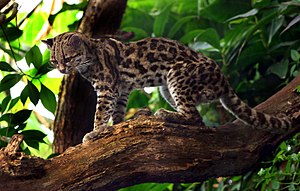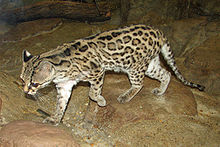Long-tailed cat
| Long-tailed cat | ||||||||||||
|---|---|---|---|---|---|---|---|---|---|---|---|---|

Long-tailed cat ( Leopardus wiedii ) |
||||||||||||
| Systematics | ||||||||||||
|
||||||||||||
| Scientific name | ||||||||||||
| Leopardus wiedii | ||||||||||||
| ( Schinz , 1821) |
The long-tailed cat ( Leopardus wiedii ), also known as Peludo , Margay , Bergozelot or Baumozelot , is a species of predator in the family of cats (Felidae) that lives on the American continent . It is slightly larger than the northern tiger cat and slightly smaller than the ocelot , both of which have similar fur colors. Long-tailed cats were formerly known for their furhunted, with thousands of animals being killed every year. However, this practice has declined sharply since the species was placed under protection in many countries in its range.
The IUCN lists the long-tailed cat on the early warning level ( near threatened ).
features
Long-tailed cats resemble the ocelot in their appearance, but are somewhat smaller and have the longer tail that gives them their name. As with this one, the fur is yellow-brown with dark, ring-shaped spots arranged in stripes. The head is short and rounded, the dark ears have, like many other types of cats, a white spot on the back. The animals reach a head body length of 46 to 79 centimeters, the tail is between 33 and 51 centimeters long and their weight varies between 2.6 and 4 kilograms. There is no noticeable sexual dimorphism .
distribution and habitat
The long-tailed cat is widespread in Central and South America east of the Andes, its range extends from northern Mexico to Uruguay and Argentina . The long-tailed cat is also counted among the fauna of North America, as a representative of this species was shot on the Rio Grande in Texas in 1852.
The habitat of the long-tailed cat is mainly forests, predominantly tropical and subtropical rainforests . Occasionally, however, it is also found on coffee or cocoa plantations. Overall, of all the cats in the Neotropical Region , the long-tailed cat is the most adapted to forest habitats. The various forests in which the animals are found include humid lowland forests, secondary and primary forests, premontane wet forests, and mountain cloud forests . The animals are rarely found at altitudes above 1200 m. In Bolivia, the long-tailed cat also lives in the relatively dry Gran Chaco .
The greatest threat today is deforestation, which continues to restrict the animals' living space. As a species that specializes in forest life, the long-tailed cat is more affected by these processes than the related ocelot. She is considered shy and rare. Despite its large distribution area, it is endangered because its habitats are limited to specific areas. The IUCN estimates that the total population will decrease by 30% over the next 18 years.
Way of life
Long-tailed cats are excellent climbers, hence the name tree ocelot. The agile animals seem to spend a large part of their lives in the trees, although they sometimes hunt on the ground. You can turn your hind legs inward enough to be able to hang down on a branch with your hind legs alone. They also have very flexible toes and very wide paws, which also helps them move safely on branches. The long-tailed cat, along with the clouded leopard and the marble cat, is one of the few species of cats that can climb down a tree upside down.
They can be active both day and night and are solitary for most of the year. Only at the mating season do they sometimes come together to form short-lived pairs. They are territorial, the areas are around 15 to 43 square kilometers.
food
Like all cats, long-tailed cats are primarily carnivores that feed on mammals (including rodents and primates ), but also birds and their eggs, lizards , tree frogs and even fruits and insects. In doing so, they primarily prey on smaller, tree-dwelling and nocturnal species such as possums , squirrels and tree rodents. However, they also beat animals up to the size of hares, agoutis and pakas .
A special feature of their hunting behavior is the imitation of voices ( mimicry ). In some cases, the long-tailed cat mimicked the voice of an injured two-tone baby tamarin in order to attract, attract, and then attack adult tamarins .
Reproduction
Little is known about reproduction; all observations so far have been made on animals in captivity. They don't have a set mating season. The sexual cycle is 32 to 36 days and within this time the females are ready to conceive for four to ten days. Copulation takes 15 to 60 seconds and ends with a typical cat bite on the neck.
The gestation period is around 76 to 84 days, and the female gives birth to one or two young per litter. The newborns are initially blind, their eyes open after two weeks, and after eight weeks they start eating solid foods. The change from milk teeth to permanent teeth takes five months. By eight to ten months, they are almost the size of an adult cat.
No data are available on how old long-tailed cats get in the wild. A captive male reached the age of 24 years.
Subspecies
In the multi-volume encyclopedia Handbook of the Mammals of the World , the following subspecies of the long-tailed cat are distinguished:
- L. w. wiedii - southeastern Brazil to northeastern Argentina
- L. w. amazonicus - Upper Amazon, Brazil
- L. w. boliviae - Andean slopes
- L. w. cooperi - Southeast Texas to the Mexican northern border (possibly extinct)
- L. w. glauculus - arid regions of Mexico
- L. w. nicaraguae - central america
- L. w. vigens - northeast Brazil to Guyana
- L. w. yucatanicus - rainforest areas of Mexico
The IUCN Cat Specialist Group, however, only recognizes three subspecies in its 2017 revision of the cat system.
- L. w. glauculus - Central America and Mexico
- L. w. vigens - South America north of the Amazon
- L. w. wiedii - Central South America south of the Amazon
Humans and long-tailed cats
The long-tailed cat, with its fur, which is traded as peludo or mountain goat , has long been one of the most important South American fur animals. In 1977 alone at least 30,000 long-tailed cat skins were traded internationally. In the meantime, the long-tailed cat is listed in the international Washington Convention on the Protection of Species in Appendix A; its fur or products made from it may not be traded.
The European Conservation Breeding Program for the Margays was introduced in 1996 and is coordinated by Sam Harley from Newquay Zoo in Cornwall, UK. In 2016 in two German zoos, in the Tierpark Berlin-Friedrichsfelde (two females) and in the Dortmund zoo , as well as in several European zoos, so u. a. in Edinburgh Zoo (a couple), in Randers Regnskov (East Jutland, Denmark), in Natura Artis Magistra (Amsterdam, Netherlands), in Jihlava Zoo (Bohemia, Czech Republic), in Welsh Mountain Zoo in Colwyn Bay (Wales) and held at the Zoo de La Boissière-du-Doré (Loire-Atlantique department, France), Margays. The Zoo de La Boissière-du-Doré succeeded in breeding in 2016.
In the report published by the Federal Ministry of Food and Agriculture in 2014, minimum requirements for the keeping of mammals are required for outdoor enclosures at least 20 m² per animal and for indoor enclosures 12 m² per pair.
literature
- Ronald M. Nowak: Walker's Mammals of the World . 6th edition. Johns Hopkins University Press, Baltimore 1999, ISBN 0-8018-5789-9 (English).
- Mel Sunquist and Fiona Sunquist: Wild Cats of the World . The University of Chicago Press, Chicago 2002, ISBN 0-226-77999-8
- Don E. Wilson, Russell A. Mittermeier (Eds.): Handbook of the Mammals of the World. Volume 1: Carnivores. Lynx Edicions, 2009, ISBN 978-84-96553-49-1 , (pp. 145 f.).
Individual evidence
- ^ Sunquist, p. 136
- ↑ a b c Wilson & Mittermeier, 2009 (p. 145 f.)
- ^ Sunquist, p. 137
- ↑ http://www.spektrum.de/alias/imitation/katze-macht-sich-zum-affen/1039270
- ↑ a b Sunquist, p. 138
- ↑ a b Sunquist, p. 139
- ↑ AC Kitchener, C. Breitenmoser-Würsten, E. Eizirik, A. Gentry, L. Werdelin, A. Wilting, N. Yamaguchi, AV Abramov, P. Christiansen, C. Driscoll, JW Duckworth, W. Johnson, S. -J. Luo, E. Meijaard, P. O'Donoghue, J. Sanderson, K. Seymour, M. Bruford, C. Groves, M. Hoffmann, K. Nowell, Z. Timmons, S. Tobe: A revised taxonomy of the Felidae . The final report of the Cat Classification Task Force of the IUCN / SSC Cat Specialist Group. In: Cat News. Special Issue 11, 2017, pp. 49–50.
- ^ EAZA activities. Complete List of EEPs and ESBs. (No longer available online.) European Association of Zoos and Aquaria 'EAZA', archived from the original on November 4, 2016 ; accessed on May 4, 2016 . Info: The archive link was inserted automatically and has not yet been checked. Please check the original and archive link according to the instructions and then remove this notice.
- ^ Animal inventory list. Mammals / predators in Dortmund Zoo. City of Dortmund / Dortmund Zoo, accessed on May 4, 2016 .
- ^ Animals & Attractions. Our animals / View all. Edinburgh Zoo, accessed May 4, 2016 .
- ↑ Guided tours // Animal encyclopedia // Mammals. Margay cat. Randers Regnskov, accessed May 4, 2016 .
- ↑ collection. Margay. Natura Artis Magistra, accessed May 4, 2016 (Dutch).
- ↑ Catalog zvířat. Margay. (No longer available online.) Jihlava Zoo, archived from the original on May 5, 2016 ; Retrieved on May 4, 2016 (cz). Info: The archive link was inserted automatically and has not yet been checked. Please check the original and archive link according to the instructions and then remove this notice.
- ↑ Mammals. Margay. Welsh Mountain Park Colwyn Bay, accessed May 4, 2016 .
- ^ Actualités du Zoo. Enfin visible! La Boissière du Doré Zoo, accessed on May 4, 2016 (French).
- ↑ Working group for the revision of the report on minimum requirements for the keeping of mammals: Report on minimum requirements for the keeping of mammals. (PDF) Predators / Small Cats / Enclosure Requirements. Federal Ministry of Food and Agriculture (BMEL) / Tierschutzreferat, May 7, 2014, p. 174 , accessed on May 4, 2016 (The report also contains an expanded requirement in the difference protocol of the representatives of the animal and nature conservation associations).
Web links
- Species profile long-tailed cat; IUCN / SSC Cat Specialist Group in English
- Leopardus wiedii in the endangered Red List species the IUCN 2008. Posted by: E. Payan u. a., 2008. Retrieved January 1, 2009.
- Rebecca Postanowicz: Margay. Archived from the original on January 4, 2009 ; Retrieved July 8, 2013 .
- Information on Animal Diversity Web (English)



